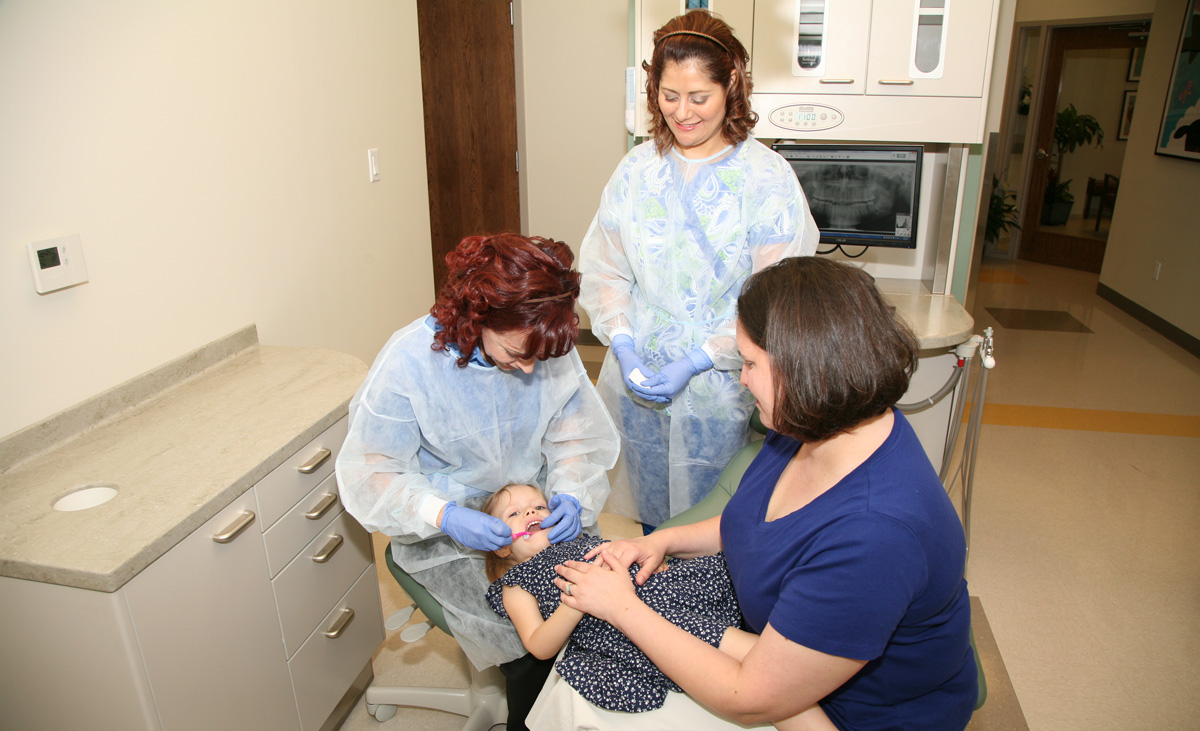Infant Oral Health
The American Academy of Pediatric Dentistry (AAPD) recommends that infants see the dentist for their first dental exam within 6 months of getting his/her first tooth or by their first birthday. After the initial dental visit, regular visits, based on the child's oral health needs, are recommended.
Birth to 6 months of age:
It is important to care for your child's teeth and dental (oral) health from birth. Practicing healthy habits can prevent or reduce tooth decay (cavities) in infants and children.
- Always clean your infant's gums after feeding:
- Cradle your baby with one arm
- Wrap a moistened washcloth around the index finger of your free hand
- Gently massage the gum tissues
- Do not put your baby to bed with a bottle, prop it in their mouth or allow your baby to feed "at will".
- Infants normally begin teething between four and six months of age. His/her gums may be red and swollen and saliva flow may increase. To ease these symptoms, give your infant a clean teething ring or cold wet washcloth. Cold temperatures are soothing, so you may want to chill the teething ring.
- Remember, dental decay is an infectious transmissible disease. Avoid testing the temperature of the bottle with your mouth, sharing utensils (e.g. spoons), or cleaning a pacifier or a bottle nipple by putting it in your mouth. These practices can help stop the transmission of bacteria that cause tooth decay (cavities).
6-12 months of age:
Between the ages of six to eight months, your baby will get his/her first tooth. It is important to care for his/her teeth right from the start. Practicing healthy habits can prevent or reduce tooth decay (cavities) in infants and children.
- Continue to clean your infant's gums after feeding. Once a tooth comes in, start to use a child's soft bristled toothbrush, with no toothpaste, in addition to massaging the gum tissues.
- To relieve the symptoms of teething, give your infant a clean teething ring or cold wet washcloth. Cold temperatures are soothing, so you may want to chill the teething ring.
- Begin to wean your baby from the bottle as your infant begins to eat more solid foods and drinks from a cup. Gradually, begin to offer a cup for water or juice. By age 12 to 14 months, most children can drink from a cup. Promote healthy habits now by limiting the frequency and amount of sweetened beverages and foods you give your child. Do not allow your baby to walk around with his/her bottle.
- Be familiar with the normal appearance of your child's gums and teeth. Regularly, lift your child's lips to check for suspicious small white or brown spots on his/her teeth. If you see these white or brown spots, which may indicate dental decay (cavities), schedule an appointment with your dentist right away.
- Schedule your child's first dental appointment. Your child should have an exam by a dentist before his/her first birthday or within 6 months after the first tooth comes in.
- If your drinking water is not fluoridated, talk to your pediatrician about infant fluoride supplements.
- Remember, dental decay is an infectious transmissible disease. Avoid testing the temperature of the bottle with your mouth, sharing utensils (e.g. spoons), or cleaning a pacifier or a bottle nipple by putting it in your mouth. These practices can help stop the transmission of bacteria that cause tooth decay (cavities).
12 to 18 months of age:
By the age of one, your child should have an oral examination by a dentist.
- Continue to brush your child's teeth twice a day with plain water
- Regularly, lift your child's lips to check for suspicious small white or brown spots on his/her teeth. If you see these white or brown spots, which may indicate dental decay (cavities), schedule an appointment with your dentist right away.
- If your child has not seen a dentist for their first dental exam, schedule an appointment.
- Continue to take steps to avoid passing decay causing germs to your child.
18 months to age 5:
By 30 months of age, all of the primary (first) teeth should have come into the mouth. By age 3, most toddlers should have stopped using the pacifier and/or sucking his/her thumb.
- At age 2, begin brushing with a pea-sized amount (small smear) of fluoridated toothpaste. Teach your child to spit out the toothpaste. Observe to insure that your child does not swallow the toothpaste.
- Begin to teach your child how to brush his/her teeth. Generally, children will need help with brushing until they have the hand coordination to clean their own teeth effectively. Children should be able to brush unsupervised by the age of six or seven.
- Continue to regularly lift your child's lip to check for suspicious small white or brown spots on his/her teeth. If you see these white or brown spots, which may indicate dental decay (cavities), schedule an appointment with your dentist right away.
- Bring your child to his/her dentist for a regular checkup.
- Talk with your dentist if your child is over age 3 and regularly sucks a pacifier or fingers or a thumb.


